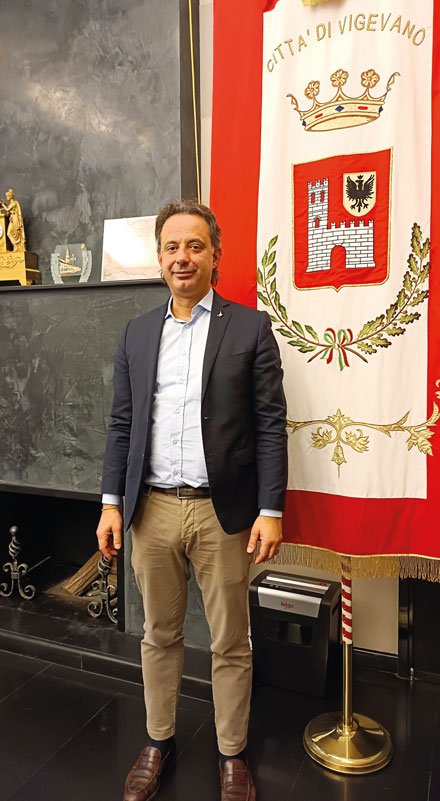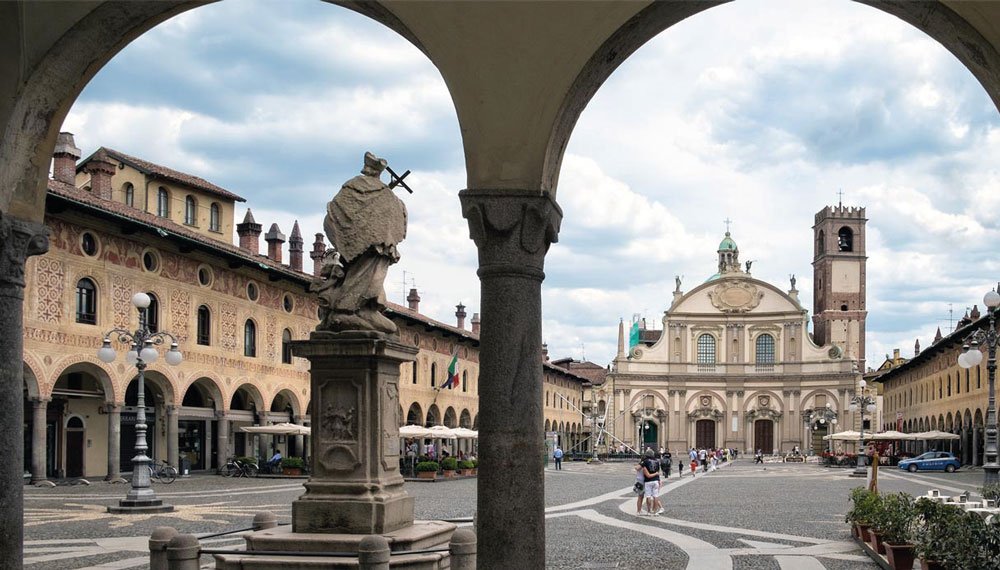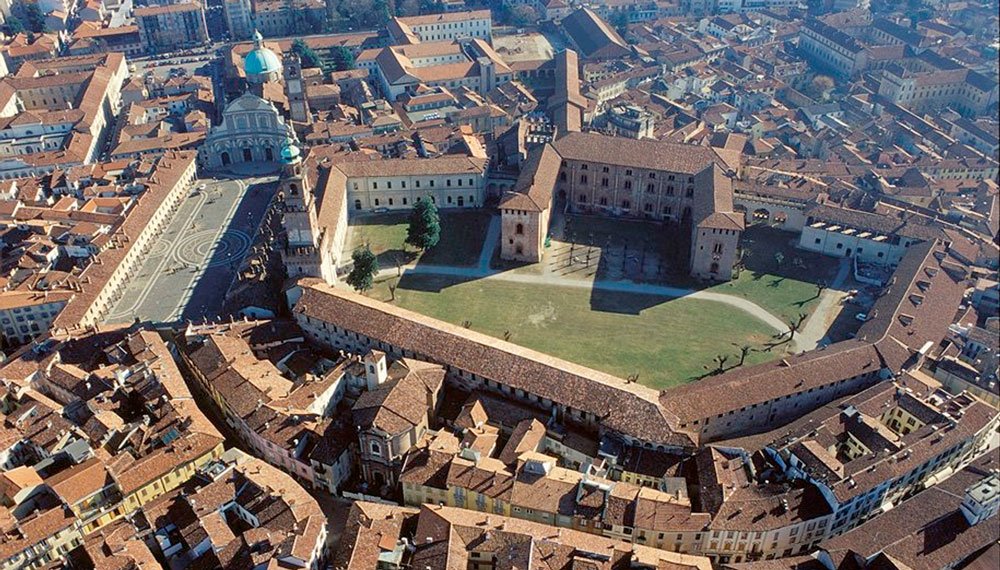Goals and hopes of a city that has become a symbol of the footwear industry in the world and now faces great challenges

The mayor of Vigevano Andrea Ceffa
Just days before the close of the annual Assomac assembly, we met Andrea Ceffa, Mayor of the Vigevano, who outlines the condition of the “footwear capital.” We recall that it was right in Vigevano, back in 1866, that the first footwear factory with an industrial model was born, and shortly afterwards it became a true international model, exporting millions of shoes all over the world. Like every city, Vigevano has also gone through its evolutionary phases undergoing profound transformations. These changes not only involved urban planning, but above all supported the expansion and contraction of its economic system, determining its development.
Mayor, how is the current state of health of Vigevano? “From a strictly industry perspective, there are obviously far fewer shoe factories than in the past. Most of those that remain, are shoe factories that work for third parties, for important designers such as Manolo Blahnik or Christian Louboutin, and produce very high-quality shoes. We can no longer speak of true mass production, but still of high-quality production. In Vigevano, as in Parabiago for example, the great expertise of savoir-faire, of know-how, has remained.”
Over the years, shoe companies have declined, but the footwear machinery sector is growing, as confirmed in the latest Assomac report just released. Is it correct? “Today it is the predominant sector, that still holds out in a significant way and counts Italian companies as leaders at an international level within it. With the passing of time, Vigevano has changed its connotation, but it always stands out for the great competence in making footwear so much that one of the big problems we have heard about at the Fair since the market restarted is precisely the difficulty in finding labor. Since the 1960s, the world of the footwear industry has changed profoundly because large-scale production has moved to the Marche region. The same thing has happened to the physiology of our city. Today, in our area, there are companies that mainly make elegant shoes for men and a specific type of footwear for women. In any case, despite the difficulties, footwear machinery still remains a point of reference: this is demonstrated by the fact that here, in the province of Pavia, there are 70 percent of the industries in this sector.”
How much does this matter on the social fabric? “It matters so much that our city, compared to others, is affected much more because, evidently, when there is a crisis in the manufacturing sector, or an economic crisis, jobs decrease and companies close. To aggravate the situation, one has to consider that a number of important services, such as the Judicial Court, have been relocated to the city of Pavia. It is obvious that Vigevano has suffered in recent years because it has always been a wealthy city – and probably still is if we speak in terms of bank deposits – but it has been impoverished from an absolute economic and consequently cultural point of view.”
Is there a glimmer of light on the horizon? “In addition to the great unknown caused by the current international situation, companies in the sector are definitely discounting a major rebound again this year, but there is cautious optimism. The industry is reporting double-digit growth.”
Mayor, what is the biggest challenge you face today? “We have been talking about the crisis for years, but one of the biggest challenges for Vigevano is the issue of infrastructure because our area lacks the highway, road and rail connections necessary for its development. We are very close to Milan, and we historically gravitate around the Lombardy capital, but we don’t have a serious connection to the airport, to the ring roads, or even a nearby highway exit. We have a railway line used by more than 8,000 commuters who travel to Milan every day but it is absolutely worthless in terms of service quality. We must emphasize that unfortunately, we are not the major players in the game because infrastructure is mainly decided by neighbouring metropolitan cities. To some extent, we must suffer them. We have been living with this situation for more than 40 years, and it is obvious that in order to consolidate our business network, infrastructure works as the role of an engine and the driver for development.”
I gather that there is no partnership with other cities… “It is not easy but we are still trying to create an effective territorial network. Years ago, we had also tried to join the metropolitan city with a special project that would bring together our cities (Vigevano, Pavia and Milan) but the project was put on ice. What we are interested in today is to have more possibilities to play this game as main players.”
The latest report of Assomac talks about de-globalization: brands are bringing their production back to Europe and Italy. Is the local dimension a limitation or an added value? “I don’t think it is a limitation; on the contrary, a dimension like ours it can be a plus. This is precisely why I have always maintained that infrastructure is of crucial importance today because our size, that of the average city, is definitely a value: our municipality has all the services available, there are universities and we have an important cultural heritage. Let’s not forget the Ticino Park. In Vigevano we live qualitatively well and it has all the characteristics to be a kind of incubator city for new projects. If the infrastructure grows, we would also see a revaluation of its real estate value and, predictably, we would become attractive not only for industry.”
Speaking of industry, how are you addressing the problem of the lack of skilled labor and the flight of young people abroad? “Let’s say that training is not a specific competence of municipal administrations because it is the responsibility of the Province and the Region however, in recent years, we have always tried to create a network of collaboration with both associations and companies. Some time ago there was talk of a footwear hub right in Vigevano but the project did not get off the ground. The role we can play is to support those who want to put in place training actions, which is what I think is lacking right now. Creating a school that can become an asset for everyone is a great goal that, despite the efforts put in place by trade associations, is struggling to get off the ground. Another aspect to consider, which many business owners have also confirmed, is the impossibility of eliminating in the mentality of young people the notion that working in manufacturing companies is undignified. The factories today are not like the ones our parents worked in. Some resistance still needs to be overcome, but it would be desirable to work on such a joint project.”
What is the project you are working on that would make you most proud to have been a proponent of? “I would like it if, with the collaboration of the administration and together with the trade associations, we could find a place that would become an element of attraction and, in agreement with the manufacturing network, the starting point for a real revitalization of the sector, starting with training. I would like this very much because in this way we would concretely lay the foundations to create a future aimed at the development of the city and the generations to come.”
What do you think can and should be done to raise awareness among the public, businesses and politicians about contributions to cities and their needs to make it possible, as you stated, to further development and also become an international center of attraction? “We Italians possess a great fortune because we have many beautiful cities and an important cultural heritage. In addition, especially here in the north, the industrial fabric is certainly not lacking: there is Bergamo, Brescia, Milan, moreover highly competitive. I think more investment would be needed to get away from the idea of high concentration in large metropolitan cities, being able to relocate some activities and enhancing medium-sized cities like ours. This would start the real paradigm shift.”
One of your focuses is urban regeneration. Can you explain how investing in this area could create more attractiveness? “Urban regeneration is the focus of my program because it starts from the concept of avoiding further land consumption, recuperating the existing land and regenerating it in a positive way. This would have two effects: the first is to create jobs, and the second is to improve the quality of life in the city. We have won a 15-million-euro Lombardy Region tender on urban regeneration that aims not only to fix our neighbourhoods that need it most but to bring to life dynamics that remove social distress. Our desire would be to create a virtuous effect of setting the city in motion that, would trigger a kind of positive effect for the whole city through these public investments.”
From urban planning to green transition: how are you interacting with the business community on this issue? “During this term, we have thought about and set up a steering committee called Digital & Green, with the aim of providing direction to the hypothetical development of our city along these two lines. We have recently made a major technological investment on fibre optics to try to turn Vigevano into a kind of model city, building the infrastructure on which new digital technologies can rest. By creating the conditions to go in this direction, the municipality will certainly help. Other actions that we have set in motion are more of city interest, such as those dedicated to mobility: we will start with the implementation of the limited traffic zone with monitoring; Piazza Ducale will be pedestrian; there is a project to create a series of bike paths including one that involves the Ticino Park. But if a company wants to invest in green, and therefore in sustainability, we are absolutely willing to provide the support that industry may need in this transition. What is somewhat lacking now is the arrival and development of new businesses. Alongside footwear machinery, I think it is right to work alongside new sectors, such as computer engineering. We are convinced that Vigevano has this vocation and, given enough time, can develop it.”


